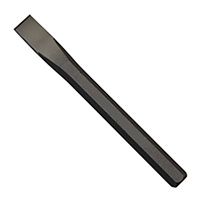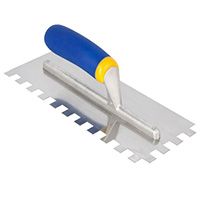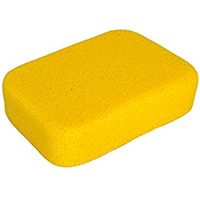We may be compensated if you purchase through links on our website. Our Reviews Team is committed to delivering honest, objective, and independent reviews on home products and services.
Replacing an old, cracked hearth with sleek slate tile can make your fireplace both safer and more stylish. It’s also a relatively do-it-yourself (DIY)-friendly task. Though we recommend consulting a contractor for code compliance and structural concerns, you should be able to handle most of the steps yourself. Our guide will walk you through the entire process, including essential techniques and safety considerations, and you can also watch the video above.
Assessing the Current Hearth
Before beginning any renovation, evaluate the existing hearth’s condition to determine the scope of work and identify any underlying issues.
During your inspection, look for gaps in the tile or grout, gaps between the hearth and firebox, and signs of heat damage or discoloration. In the video, Mark points out a concerning crack between the hearth and the firebox. Embers can fall through gaps like that and potentially ignite the wood framing underneath.
Once you have inspected the hearth, remove a section of tile to examine the sub-hearth. Typically made of concrete, the sub-hearth provides a stable base for the tile. Look for cracks or unevenness in the concrete or mortar, and tap on the surface to test the solidity. A sound sub-hearth should feel solid and show no signs of cracking or hollow spots.
Tools and Materials Needed to Replace a Hearth With Slate Tile
Gather the following tools before starting:
You will also need the following materials and safety gear:
- Dust mask
- Grout
- Painter’s tape
- Safety glasses
- Slate tile
- Small sledgehammer
- Thinset
- Tile spacers
- Work gloves
Removing the Old Tile From Hearth
The next step is to remove the existing tile. This process requires careful demolition to avoid damaging the underlying structure. Here’s a step-by-step guide to the removal process:
- Protect surfaces. Cover surrounding areas with painter’s tape and drop cloths to prevent damage.
- Chisel the first tile. Start at an edge or corner tile, placing the cold chisel straight down on the tile. Strike the chisel with the sledgehammer to break the tile.
- Pry up adjacent tiles. Once you remove the first tile, use the chisel to pry up neighboring tiles. Continue this process until you remove all the tiles.
- Clean thoroughly. Sweep and vacuum the sub-hearth to remove all loose debris.
Preparing the Sub-hearth
With the old tile removed, it’s time to prepare the sub-hearth for new tile installation. This step ensures a clean, level surface for the slate tiles. Here’s what to do:
- Repair cracks. Inspect for any cracks or damage that the told tile may be hiding. You can fill small cracks with thinset mortar. For larger cracks or extensive damage, we recommend consulting a professional.
- Level the surface. Use a long level to check for any high or low spots. Apply a self-leveling compound if necessary, following the manufacturer’s instructions.
- Let it dry. Allow the compound to dry completely before proceeding.
Selecting and Laying Out Slate Tiles
Choosing the right slate tiles and planning their layout in advance will help you achieve a professional-looking result. When selecting slate tiles for your hearth, be sure to consider the thickness, durability, and heat resistance. Most hearth tiles are 3/8 –1/2 inch thick. Look for a size, shape, and color that complements your fireplace design. For instance, the homeowners in the video chose longer slate tiles to match the length of their fireplace bricks.
Once you have your new tiles, follow these steps to plan the layout:
- Mark the center point. Measure the hearth’s width and divide by two to find the center point.
- Lay the tiles. Place a tile on either side of the center line with a spacer between the two. Continue laying out tiles from the center, using spacers to maintain consistent gaps.
- Cut end tiles as needed. Mark any tiles that you need to cut to fit at the edges. Since the cuts will be straight and simple, a manual cutter should be enough, but you could also use a wet saw.
Installing the Slate Tiles
With proper preparation and layout complete, you’re ready to install the new slate tiles on your hearth. Here’s a step-by-step guide to installation:
- Apply thinset mortar. Mix the thinset mortar according to the manufacturer’s instructions. Apply a layer of thinset to the sub-hearth using a notched trowel. Comb the thinset in one direction to create ridges for better adhesion.
- Set the tiles. Starting at the center of the hearth and working outward, press each tile firmly into the thinset. Twist slightly to ensure good contact, and use tile spacers to maintain consistent gaps.
- Clean and let the mortar set. Clean any excess thinset from the tile surfaces and joints as you go. Allow the thinset to set for 24 hours before grouting.
- Apply grout. Mix the grout according to the manufacturer’s instructions. Apply grout diagonally across the tile joints using a rubber float.
- Clean and let the grout set. Remove excess grout with a damp sponge, being careful not to pull grout from the joints. Allow the grout to set for the recommended time. After 24 hours, remove any remaining grout haze with a clean, damp sponge.
- Add the finishing touches. Apply a grout sealer if recommended for your specific grout type. Consider applying a natural stone sealer to the slate tiles for added protection.
Ensuring Hearth is Safety Compliant
After completing the tile installation, be sure to address any remaining safety concerns to ensure your new hearth is up to code. For instance, in the video, Mark explains the need to remove any remaining formwork under the sub-hearth.
If your subhearth has formwork that you must remove, wait at least a week after tile installation to ensure everything is fully set. Then access the area beneath the hearth and carefully remove any wooden formwork left from the original construction. Inspect the area to ensure no combustible materials remain close to the hearth.
Consider having a professional inspector or chimney sweep evaluate your newly renovated hearth to ensure it meets all local building codes and safety standards.





